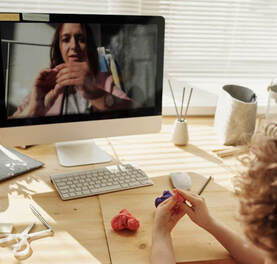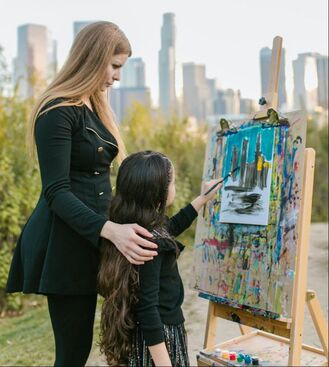|
According to the Bureau of Labor Statistics, only about one-third of businesses survive to their 10th year. We are thrilled here at Leading Tomorrow to have celebrated this milestone this past month! For the rest of this year, we will be highlighting key resources, providing new content, and having special offers to say “thank you” to those of you who have supported and worked with us over the past decade! This month, I reviewed my current Top-10 Picks for Next Gen Resources (see below). I hope you find these helpful! You can also listen to me discuss key takeaways from each resource in this month’s episode of The Leading Tomorrow podcast.
Marching Off the Map by Tim Elmore and Andrew McPeak This book was published in 2017 but continues to be my go-to resource for teaching and training strategies for Gen Z & Gen Alpha. My favorite is the EPIC model — experiential, participatory, image-rich, and connected (relational). This is how young people today learn best! Zconomy: How Gen Z Will Change the Future of Business—and What to Do About It by Jason Dorsey & Denise Villa This is the best book I have found on understanding the workplace expectations and needs of Gen Z. Practical strategies are presented for every step of onboarding a Gen Z team member, from recruiting, to training, to retention. The Culture Translator by Axis This weekly email on what is trending in culture and the lives of teens is gold. For example, did you know that in teen slang “Bop” means a really good song, “Cheugy” means awkward or cringey, and “Finna” means you are going to do something? Axis also has a podcast and many other resources for anyone wanting to understand the music, movies, shows and social media trends impacting today’s youth. Tech-Wise Family: Everyday Steps for Putting Technology in Its Proper Place by Andy Crouch and Amy Crouch My favorite all-around resource on creating a family/home culture that helps manage technology in healthy ways. A great quote from the book states: “Technology is in its proper place only when we use it with intention and care. If there’s one thing I’ve discovered about technology, it’s that it doesn’t stay in its proper place on its own; much like my children’s toys and stuffed creatures and minor treasures, it finds its way underfoot all over the house and all over our lives. If we aren’t intentional and careful, we’ll end up with a quite extraordinary mess.” Another convicting quote: “An awful lot of children have been competing with their parents’ screens for attention their whole lives.” Family Media Plan Tool by the American Academy of Pediatrics This tool walks parents and other family members through a practical list of questions to consider in creating a media plan for the young people in our lives. I appreciate how the template generates good considerations for how to help all of us manage our devices. The Anxious Generation: How the Rewiring of Childhood is Causing an Epidemic of Mental Illness by Jonathan Haidt This one was just released in March of 2024 and is already creating some powerful dialogue regarding how childhood has changed, what young people need, and how adults need to be intentional and unrelenting in creating environments for the next gen that counter the mental health epidemic and related challenges. Kids’ Brains and Screens: A ScreenStrong Student Course by Melanie Hempe Finally, a practical resource for educating and equipping young people to understand the impact of screens on their developing brains and lives. While most resources on technology speak to adults, this curriculum is designed for middle school students and presents information in a fun and engaging way. ScreenStrong has other resources as well. Generations: The Real Differences Between Gen Z, Millennials, Gen X, Boomers, and Silents - and What They Mean for America’s Future by Jean Twenge Dr. Jean Twenge is one of the most noted researchers on generational trends. In this, her latest book, she highlights key factors that contribute not only to the perspectives and behaviors of the youngest generations, but the trends that have impacted all of the living adult generations today. Touch the World Youth & Young Adult Mission Training and Trips Committed to equipping the next generation to live on mission every day, everywhere, Touch the World has some of the best training materials and programs out there for engaging Gen Z in missions. They offer in-person and online training, as well as short-term trips, internships, and a gap year program. Gen SeXYZ: Love, Sexuality and Youth by Jeff Grenell In the opening chapter, Grenell states: “One of the cultural realities of the Millennial and Gen Z sets is that they are living in a real and historic sexual revolution. Maybe the most staggering society-shifting tsunami to ever hit the shores of youth.” He continues to unpack the sexual revolution occurring today and offers practical strategies for anyone mentoring the next generation.
0 Comments
Younger generations are growing up with unprecedented access to news, images, and information often portraying traumatic experiences and situations. In addition, they are connected 24/7 to friends and family members who may be struggling with trauma, mental health issues, or other concerns. The result is that many Gen Zers, in addition to experiencing trauma in their own lives, are coping with vicarious trauma.
Vicarious or secondary trauma occurs when exposed to someone else's trauma--trauma you have not experienced yourself, but learned about from other people or sources. In the past, vicarious trauma was especially notable in professionals working in the medical field, counseling, social work, emergency services and similar fields. Today, however, the constant exposure to information can result in an increased risk of vicarious trauma for anyone, especially for young people who are still developing their understanding of the world, self awareness, and self management skills. On this month's episode of The Leading Tomorrow podcast, I am joined by James LaLonde to discuss how we can help protect young people, and support them when they are experiencing the effects of vicarious trauma. Some of the strategies discussed include:
 Despite many schools and work activities being back in person, virtual classes, training, and work meetings continue to be a significant part of our daily interactions, and will likely continue indefinitely. As a result, we must constantly hone our virtual interaction skills. Her are four of my favorite tips for communicating and building relationships in virtual contexts. -Tip 1: “Push” Important Info to Students/Team Members We live in a world where notifications and reminders help us focus on what is important amid the onslaught of information we encounter. As a result, we need to “push” important information to students and colleagues. Extra reminders to team members on upcoming meetings or tasks can be helpful. Students may need support as they navigate online learning. I do this by posting and emailing weekly updates, highlighting what is important in each module. During the first couple of weeks of class, or when there is a new type of assignment or activity, I post/send a special reminder or explanation, even though all this info is also clearly posted online. Students benefit from knowing what to focus on, understanding how to manage their time, and getting information that minimizes mistakes or confusion. -Tip 2: Be Present/Engaged In the online context, students and employees cannot “see” us the way they do in a classroom or office, so we need to be intentional to show we are present and engaged. We can do this by contributing to discussion on forums, liking or responding to comments, and making specific comments unique to each student or participant when responding. I also try to reference student comments or insights when giving video lectures or facilitating discussions to show I am paying attention to what they are saying and doing. -Tip 3: Be Personable/Authentic Being personable online requires us to really express our personality. Including some videos and facilitating live discussions helps convey our teaching style. I always host a virtual orientation the first week of class so we can see facial expressions and hear voices. We can let our personality shine through in videos, posts, and comments by sharing personal fun facts and stories or using emojis. Also, responding to employee or student needs and requests for help with empathy goes a long way toward building rapport. -Tip 4: Connect Individually Learn specifics about each student or team member, reference these, share resources they might find interesting given their interests, etc. I create an introduction forum and ask everyone to post a short bio during the first week of my courses. This helps me learn and remember names and backgrounds. Responding promptly to questions and creating times or opportunities for appointments if students or staff need to connect via phone or video chat communicates you are available to help them.  Almost two decades ago, futurist and inventor, Ray Kurzwelli stated, "We're entering an age of acceleration. Because of the explosive power of exponential growth, the 21st century will be equivalent to 20,000 years of progress at today's rate of progress; organizations have to be able to redefine themselves at a faster and faster pace." As we look at the world around us today, we can see evidence of rapid change. Change in technology, society, and generations requires leaders and organizations to adapt and innovate. This month, I had the honor of sitting down and chatting about innovation with Jacob Hancock, Executive Director at Seeds Global Innovation Lab. To hear our full discussion, check out this month's episode of The Leading Tomorrow Podcast. Jacob gave the following definition of innovation: "proactively generating and executing new ideas that create value." He went on to explain, "If we solve for challenges in the future, we are so much more prepared than if we remain in a reactive posture." One of the challenges of innovation is the fact that it requires some tolerance of failure as we seek to learn what will work in a new context. William Pollard indicated why being willing to learn is so critical: "Learning and innovation go hand-in-hand. The arrogance of success is believing what you did yesterday will be sufficient tomorrow." As we consider engaging, equipping, and encouraging a new generation of young leaders, we must be willing to innovate and model what courageous learning and growth look like in a complex and rapidly changing world. Below I have listed some great resources on innovation, growth and design thinking! I encourage you to add one or two to your reading list for 2022! Resources on Creativity, Innovation & Growth: Creative Confidence: Unleashing the Creative Potential Within Us All by Kelley & Kelley Creativity, Inc.: Overcoming the Unseen Forces that Stand in the Way of True Inspiration by Catmull & Wallace Innovation by Design: How Any Organization Can Leverage Design Thinking to Produce Change, Drive New Ideas, and Deliver Meaningful Solutions by Lockwood & Papke Designing for Growth: A Design Thinking Kit for Managers by Liedtka & Ogilvie 101 Design Methods: A Structured Approach for Driving Innovation in Your Organization by Vijay Kumar  “Sharenting” is a term that describes sharing about kids or young people online. “Sharenthood: Why We Should Think Before We Talk About Our Kids Online,” is a new book by Leah Plunkett. Plunkett argued that “sharenting” happens any time an adult in charge of a child’s well-being, such as a parent, grandparent, teacher or coach, transmits private details about a child via digital channels such as social media. Some of these activities clearly involve a public share, such as posting pictures of your child on Instagram, or blogging about your kids. Others seem to happen in private, but often end up turning your child into a set of data points, via fertility apps or Amazon wish lists, the use of a Nest cam, or photos stored on a cloud server. Though these platforms and devices aren’t necessarily exploitative, Plunkett argues that they involve adult decisions that accelerate a child’s entry into “digital life.” A struggle for many of us is that we want to share about our kids for family and friends; cute kids are a positive feature on social media as compared to some other types of posts; they get likes and comments which make us feel good; and social media is now part of the world we live in. So, is concern over too much “sharenting” warranted? Tim Elmore shares a story on his blog that illustrates one of the potential dangers of too much “sharenting:” It all started when April, Christine’s youngest daughter, was five years old. Christine knew April would be their family’s last baby and wanted to document each milestone and comical moment of her childhood. By the time she was ten, April was avoiding photo ops; shying away from the camera. By 13, when she had a phone of her own, April witnessed on social media just how much mom had posted on both Facebook and Instagram. She felt violated. Eventually, as a teen, April requested her mom stop sharing photos of her. It was embarrassing and drew sarcasm from her friends. In my relationship with my own kids, I have seen the shyness or embarrassment on occasion that result when they realize I have shared something about them. It has made me realize that no number of likes are worth hurting my relationship with my kids. While kids may not need full agency to dictate what can be shared about them at a young age, we don’t want to violate their trust. It can be difficult finding the balance between honoring and celebrating or sharing, and jeopardizing trust. Another real factor is privacy and security. The BBC reported on a study by Barclays bank estimating that by 2030 nearly two-thirds of identity-fraud cases affecting today’s children will have resulted from sharenting. The bank warned that parents might be "lulled into a false sense of security" and fail to understand that they are making their children "fraud targets" in the future, by publishing so much personal information which will remain online forever. Tim Elmore shares some practical guidelines to consider as we share about our kids, grandkids, or other young people online:
 Like many of you, I remember the days before social media and smartphones. Now, it seems we can’t live life without them. From checking in with family to accessing the weather, news, and sports, most Americans now seem inseparable from their devices. These devices also accompany us to work, where we utilize them there as well. As a Generation Z researcher, I wanted to see how this generation uses technology in the workplace, and how employers can utilize their innate expertise. Having grown up in the late 90s and 2000s, Generation Z has always had the internet and smart technology at their fingertips. A 2019 study by Adage indicated that 98% of Gen Z’ers surveyed owned smartphones and 94% owned laptops. Gen Z engages with friends, interests, and now school almost entirely through their devices. Several recent studies also revealed that Gen Z is more comfortable working from a tablet or smartphone than laptop or desktop in a work environment and use their smartphone at work as their primary communication tool. Gen Zer’s want to work in an environment that has fast, reliable tech, and wants to use this tech to communicate with their supervisors and colleagues. Gen Z are well-acquainted with video tools like Zoom and Skype, having used FaceTime and Snapchat throughout their teen years. COVID-19 has forced many employers to shift to remote work. While many Gen Zer’s, Millennials, and Gen X’ers are used to using applications like Zoom, MS Teams, and Skype, learning to navigate these apps under the pressure of working from home can be difficult and stressful for many older employees. We’ve all received the frantic text, call or message, “How do I turn on my camera??”. To assist older employees with using video, chat, or other workplace technology, I recommend utilizing your Generation Z employees’ expertise. Utilizing Gen Z’s technological skills may help your company in a couple of ways. Appointing young employees as leaders in this area may help you better engage with and retain this group of employees. Research shows that Gen Z needs to feel a sense of purpose, achievement, and advancement in their job, or they will quickly move on. Designating Gen Z’ers as the go-to for team tech questions will give them a sense of accomplishment and an opportunity to display leadership even if they are in frontline or entry roles. Pairing older employees with Gen Z’ers may also have an added benefit – as members of Generation Z communicate with and help their team members, the mature team members also have an opportunity to get to know the younger members. Perhaps the director or VP who would never get to know the frontline employee is suddenly relying on them for virtual tech assistance. What an amazing chance for a learning exchange to occur! While the Gen Z employee assists with technology, the more tenured employee also has an opportunity to mentor or provide wisdom to the younger employee, which may outlast the tech questions and strengthen the virtual team. Note: I recommend inviting rather than assigning Gen Z’ers to help their team members access and troubleshoot tech– you will receive a much more favorable response (a monetary or non-monetary incentive such as an extra day off, small gift, or bonus may also help). Growing up in an age of rapidly expanding technology and a constant information stream, Generation Z possesses skills and ideas that organizations should employ. Utilizing Gen Z’s technological skills is one way to engage younger employees and strengthen your virtual teams during COVID-19.  Clinical psychologist, Benjamin F. Miller, wrote that America was already on track to face a mental health crisis before the COVID-19 outbreak. While many Americans are feeling the emotional toll of the pandemic, Millennials and Generation Z represent particularly vulnerable groups. Many were already suffering from declining mental health. The new normal of social distancing is increasing the loneliness and isolation that so many within these generations are experiencing. Many argue that technology allows us to connect effectively even while separated physically. While this is true, we know that in-person interaction is better for emotional health than virtual connection. Jean Twenge, in her book, iGen addresses this issue. She explains that if virtual connection were as valuable as face-to-face connection, then “teens who communicate via social media and text should be just as happy, be just as likely to dodge loneliness, and be just as likely to avoid depression as teens who see their friends in person or engage in other activities that don’t involve screens.” However, the research demonstrates that, “teens who spend more time on screen activities are more likely to be unhappy, and those who spend more time on nonscreen activities are more likely to be happy….all screen activities are linked to less happiness, and all nonscreen activities are linked to more happiness.” As we consider this research alongside the fact that most classes, church groups, sports practices, even some camps, not to mention almost all social interactions, have been moved to a virtual format involving screens, the potential for increased depression, unhappiness, and loneliness is evident. While technology is undoubtedly a gift during this time, it is not without significant risks. Twenge reports that “the correlation between social media use and loneliness appears across all demographic groups: boys and girls, Hispanics, whites, and blacks, and those both lower and higher in socioeconomic status.” Twenge also reports that “eighth graders who are heavy users of social media increase their risk of depression by 27%, while those who play sports, go to religious services, or even do homework cut their risk significantly” and that “teens who spend more than three hours a day on an electronic device are 35% more likely to have at least one suicide risk factor.” Research by Brigham Young University indicates that loneliness and social isolation may represent a greater public health hazard than obesity and present a risk for premature mortality. Nicolas Kardaras in his book, Glow Kids, explained children between the ages of 10 and 17 today will experience nearly one third fewer face-to face interactions with other people throughout they lifetimes as a result of their increasingly electronic culture, at home and in school. He goes on to explain that “an emotional connection is built, however, when eye contact is made during 60-70% of the conversation…the less eye contact, the less a connection is made.” Our kids, teens, and young adults today desperately need the emotional connection that comes from meaningful face-to-face time. Peter Gray, my favorite researcher on the importance of play, notes a correlation between a decrease in playtime and a rise in major depression, anxiety, and suicide. Gray writes, “If we love our children and want them to thrive, we must allow them more time and opportunity to play, not less.” As we navigate a season where many playgrounds are closed, sports and team events are cancelled, and other activities are being held virtually, we must be vigilant to monitor the mental and emotional health of the young people in our lives. Reduced emotional connection and increased risks for loneliness and depression are serious threats to the well-being of our young people at this time. We must be proactive to find ways to meet their needs for face-to-face interaction, emotional connection, and healthy activity and play in ways that will allow them to thrive.  The following is a guest post from Josiah Cassellius, a Millennial writer and producer. Humanity has always compartmentalized the different aspects of life; let’s call them our different faces for different occasions. This is the idea that we treat our mothers differently than we treat our fathers. We say things to our friends that our grandmother would chastise us for repeating to her. For most of us, only a handful of people ever get to see our vulnerable side. We are good at it, you see, very good at adapting to our surroundings. So good, it seems, that we have decided to enter ourselves into the next level of competition. In the past we fragmented across our home lives, friendships, and work. Generally, it was a very small community, but that has changed. Today, thanks to technology, we interface with people everywhere, and the fragmentation of our identity has expanded. This reality can make it hard to prioritize our focus. One could be forgiven for being uncertain in what order to place the dozens of fragments of our lives, it is, after all, a very complicated question. It used to go something like this: faith, family, friends, work, then everything else. Such a simple, yet elegant, system. Except that now work has been sub-divided even further for most, and friends and family are more spread out than ever. In the midst of such fragmentation, we often resort to tribalization. It is a phenomenon that helped people survive harsh environments and threats. While it worked for hunter/gatherers, in an increasingly interconnected world, one that overwhelms us, it may not be effective. Much the same way that there is a sense of peace and security in our homes during a storm, we enter into our sacred bubble and push the world out, and when we do come out to see what is happening, it can seem like we are entering a war zone. The outrage, the accusations, the controversy we see around us all lead to alienation. We run to our tribe, what feels familiar and friendly, and we label anyone not in our bunker as the enemy and reconciliation becomes nearly impossible. The reality, though, is that the circumstances do not merit such distress. People are becoming more self-aware as to biases and opinions that are destructive. However, we no longer sit down and read the news and digest and discuss it rationally with friends and family whom we trust. Instead, we read headlines and tweets and use them to reinforce our narratives and we scream out into the void, and if we are unfortunate enough to receive an answer that contradicts us, we lash out. So, what can we do? When we read something online that we disagree with, we need to not assume ill-intent, that only breeds more anger. Give the benefit of the doubt to a person, and maybe we will see them, and their ideas, in a new light. A positive approach may even open the door for healthy dialogue. Let’s turn our online spaces into the homes and meeting-places of old, where we come together to express ideas, and to help each other understand the true meaning of what a community can be. Be open to hearing dissenting views, and be prepared to admit fault, and potentially, we may just escape unscathed. As a toddler who is overwhelmed by emotions cries out in frustration, so also adults who are stretched too thin react poorly to push-back. When we feel ourselves becoming overwhelmed, we need to reconnect with our fragmented selves, identify what is truly important, and remember that reality is not online.  In his short story, A Christmas Tree, Charles Dickens writes: “I have been looking on, this evening, at a merry company of children assembled round that pretty German toy, a Christmas tree.” He describes the wonder of the children as they looked at the ornaments. “This motley collection of odd objects, clustering on the tree like magic fruit—some of the diamond eyes admiring it were hardly on level with the table, and a few were languishing in timid wonder on the bosoms of pretty mothers, aunts, and nurses—made a lively realization of the fancies of childhood.” Our children today do not have the same experiences as the children Dickens describes. Lights on a tree hardly hold the same wonder when they compete with high definition screens. Imaginations are not ignited with wonder, sitting and staring at twinkling ornaments, when they are stimulated instead by continuous noise from handheld devices. Furthermore, innocent ponderings are interrupted by mature content, flowing into our homes and lives via technology. Tim Elmore, in his book, Marching Off the Map, describes, “We have now begun to experience a strange paradox in our young: The extinction of childlikeness; the extension of childishness.” He explains that the “infectious flow of information” is exposing our kids to adult topics. As a result, they can “lose (1) their sense of innocence, (2) their sense of wonder and (3) their sense of trust.” Not only are we losing our child-like wonder today, but also our ability to connect with our environment, the way people used to engage the beauty of simple things like Christmas decorations. Kirsten Weir wrote a fascinating article, “Never a Dull Moment.” She explains how in today's technological world, it's unusual to be stuck with absolutely nothing to do. “Most of us are bombarded by near-constant stimuli such as tweets, texts and a seemingly limitless supply of cat videos right at our fingertips. But all those diversions don't seem to have alleviated society's collective boredom.” She cites Psychologist John Eastman who says the reverse may be true. "These might distract you in the short run, but I think it makes you more susceptible to boredom in the long run, and less able to find ways to engage yourself," he says. Weir reports that several researchers concluded boredom is best described in terms of attention. “A bored person doesn't just have nothing to do. He or she wants to be stimulated, but is unable, for whatever reason, to connect with his or her environment.” Connecting, and helping others connect, with the environment around us is critical as we seek to develop meaningful moments and lasting memories this Christmas. Most of us are used to our environment stimulating us, and if we are bored, we reach for a device. We have lost some of our ability to connect with each other. When we get together for holiday parties, and family gatherings, we often struggle to stay engaged with the people or activities around us and can be tempted to seek stimulation in our social media feed, text messages, or email notifications. Creating meaningful memories may require some discipline and planning. We can start by being aware of when we are tempted to pull out our device, instead of engaging with someone who is in the room with us. We have to be intentional in creating focused time for interaction. For example, designing a fun box for phones and encouraging people to drop theirs in during family dinner. Planning some interactive activities (games, discussion questions, collaborative project) can give people tools to engage with each other rather than turning on video games or a movie. We must practice good emotional intelligence by asking questions, engaging others in conversation, and modeling for kids how to build relationships. In her article, Weir cites researcher Van Tilburg. "We saw that boredom actually increased people's tendency to recall these very nostalgic memories and actually made them feel that life in general was more meaningful." Some boredom is essential to the wonder that Dickens described! It creates room for the most nostalgic and memorable moments to occur and be remembered. So, this Christmas, don’t just hand the kids a device, rather sit down with them to play a board game, decorate cookies, or share stories by the fire. When they complain about being bored, just smile!  Research continues to link the overuse of technology to depression, attention issues, and poor social skills. Many parents and grandparents I talk to feel overwhelmed by the powerful influence of technology in their families and homes. Technology, if not managed, can impair our family's wellbeing. One of our best defenses against devices controlling our time and relationships is to develop a culture in our homes that encourages healthy technology use. So, how do we go about inspiring a tech-smart family? Here are a few strategies and resources: So, how do we go about inspiring a tech-smart family? Here are a few strategies and resources:
Book Jolene to speak to your church, school, or community group on Tech-Smart Parenting or visit the Leading Tomorrow podcast for more on this and related topics! |
AuthorDr. Jolene Erlacher is a wife, mommy, author, speaker, college instructor and coffee drinker who is passionate about empowering the next generation of leaders for effective service! Archives
May 2024
Categories
All
|

 RSS Feed
RSS Feed